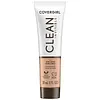Covergirl Clean Invisible Foundation Versus NYX Cosmetics Can't Stop Won't Stop Full Coverage Foundation
What's inside
What's inside
 Key Ingredients
Key Ingredients

 Benefits
Benefits

 Concerns
Concerns

 Ingredients Side-by-side
Ingredients Side-by-side

Water
Skin ConditioningDimethicone
EmollientPropylene Glycol
HumectantCaprylyl Methicone
Skin ConditioningDicaprylyl Ether
EmollientCetyl PEG/PPG-10/1 Dimethicone
EmulsifyingSilica
AbrasivePEG-10 Dimethicone
Skin ConditioningSodium Chloride
MaskingDisteardimonium Hectorite
StabilisingTribehenin
EmollientGlycerin
HumectantPhenoxyethanol
PreservativeTocopheryl Acetate
AntioxidantTriethyl Citrate
MaskingChlorphenesin
AntimicrobialMethicone
EmollientAlumina
AbrasivePropylene Carbonate
SolventTocopherol
AntioxidantPentaerythrityl Tetra-Di-T-Butyl Hydroxyhydrocinnamate
AntioxidantCI 77891
Cosmetic ColorantMica
Cosmetic ColorantIron Oxides
Water, Dimethicone, Propylene Glycol, Caprylyl Methicone, Dicaprylyl Ether, Cetyl PEG/PPG-10/1 Dimethicone, Silica, PEG-10 Dimethicone, Sodium Chloride, Disteardimonium Hectorite, Tribehenin, Glycerin, Phenoxyethanol, Tocopheryl Acetate, Triethyl Citrate, Chlorphenesin, Methicone, Alumina, Propylene Carbonate, Tocopherol, Pentaerythrityl Tetra-Di-T-Butyl Hydroxyhydrocinnamate, CI 77891, Mica, Iron Oxides
Water
Skin ConditioningDimethicone
EmollientIsododecane
EmollientNylon-12
Acrylates/Polytrimethylsiloxymethacrylate Copolymer
Skin ConditioningSilica
AbrasiveButylene Glycol
HumectantPEG-10 Dimethicone
Skin ConditioningIsohexadecane
EmollientIsononyl Isononanoate
EmollientPentylene Glycol
Skin ConditioningSynthetic Fluorphlogopite
Bis-PEG/PPG-14/14 Dimethicone
EmollientMagnesium Sulfate
Phenoxyethanol
PreservativeCaprylyl Glycol
EmollientAcrylonitrile/Methyl Methacrylate/Vinylidene Chloride Copolymer
Disodium Stearoyl Glutamate
CleansingDisteardimonium Hectorite
StabilisingCalcium Gluconate
HumectantPerlite
AbsorbentMagnesium Gluconate
Skin ConditioningTocopherol
AntioxidantAluminum Hydroxide
EmollientIsobutane
CI 77891
Cosmetic ColorantIron Oxides
Water, Dimethicone, Isododecane, Nylon-12, Acrylates/Polytrimethylsiloxymethacrylate Copolymer, Silica, Butylene Glycol, PEG-10 Dimethicone, Isohexadecane, Isononyl Isononanoate, Pentylene Glycol, Synthetic Fluorphlogopite, Bis-PEG/PPG-14/14 Dimethicone, Magnesium Sulfate, Phenoxyethanol, Caprylyl Glycol, Acrylonitrile/Methyl Methacrylate/Vinylidene Chloride Copolymer, Disodium Stearoyl Glutamate, Disteardimonium Hectorite, Calcium Gluconate, Perlite, Magnesium Gluconate, Tocopherol, Aluminum Hydroxide, Isobutane, CI 77891, Iron Oxides
 Reviews
Reviews

Ingredients Explained
These ingredients are found in both products.
Ingredients higher up in an ingredient list are typically present in a larger amount.
Ci 77891 is a white pigment from Titanium dioxide. It is naturally found in minerals such as rutile and ilmenite.
It's main function is to add a white color to cosmetics. It can also be mixed with other colors to create different shades.
Ci 77891 is commonly found in sunscreens due to its ability to block UV rays.
Learn more about CI 77891Dimethicone is a type of synthetic silicone created from natural materials such as quartz.
What it does:
Dimethicone comes in different viscosities:
Depending on the viscosity, dimethicone has different properties.
Ingredients lists don't always show which type is used, so we recommend reaching out to the brand if you have questions about the viscosity.
This ingredient is unlikely to cause irritation because it does not get absorbed into skin. However, people with silicone allergies should be careful about using this ingredient.
Note: Dimethicone may contribute to pilling. This is because it is not oil or water soluble, so pilling may occur when layered with products. When mixed with heavy oils in a formula, the outcome is also quite greasy.
Learn more about DimethiconeDisteardimonium Hectorite comes from the clay mineral named hectorite. It is used to add thickness to a product.
It can also help stabilize a product by helping to disperse other ingredients.
Hectorite is a rare, white clay mineral.
Learn more about Disteardimonium HectoritePeg-10 Dimethicone is silicone with conditioner and emulsifier properties. It mostly acts as an emollient in skincare and and humectant in haircare.
According to the manufacturer, acidic formulations decrease the stability of this ingredient. It works best in neutral or near neutral formulations.
Phenoxyethanol is a preservative that has germicide, antimicrobial, and aromatic properties. Studies show that phenoxyethanol can prevent microbial growth. By itself, it has a scent that is similar to that of a rose.
It's often used in formulations along with Caprylyl Glycol to preserve the shelf life of products.
Silica, also known as silicon dioxide, is a naturally occurring mineral. It is used as a fine, spherical, and porous powder in cosmetics.
Though it has exfoliant properties, the function of silica varies depending on the product.
The unique structure of silica enhances the spreadability and adds smoothness, making it a great texture enhancer.
It is also used as an active carrier, emulsifier, and mattifier due to its ability to absorb excess oil.
In some products, tiny microneedles called spicules are made from silica or hydrolyzed sponge. When you rub them in, they lightly polish away dead skin layers and enhance the penetration of active ingredients.
Learn more about SilicaTocopherol (also known as Vitamin E) is a common antioxidant used to help protect the skin from free-radicals and strengthen the skin barrier. It's also fat soluble - this means our skin is great at absorbing it.
Vitamin E also helps keep your natural skin lipids healthy. Your lipid skin barrier naturally consists of lipids, ceramides, and fatty acids. Vitamin E offers extra protection for your skin’s lipid barrier, keeping your skin healthy and nourished.
Another benefit is a bit of UV protection. Vitamin E helps reduce the damage caused by UVB rays. (It should not replace your sunscreen). Combining it with Vitamin C can decrease sunburned cells and hyperpigmentation after UV exposure.
You might have noticed Vitamin E + C often paired together. This is because it is great at stabilizing Vitamin C. Using the two together helps increase the effectiveness of both ingredients.
There are often claims that Vitamin E can reduce/prevent scarring, but these claims haven't been confirmed by scientific research.
Learn more about TocopherolWater. It's the most common cosmetic ingredient of all. You'll usually see it at the top of ingredient lists, meaning that it makes up the largest part of the product.
So why is it so popular? Water most often acts as a solvent - this means that it helps dissolve other ingredients into the formulation.
You'll also recognize water as that liquid we all need to stay alive. If you see this, drink a glass of water. Stay hydrated!
Learn more about WaterThis ingredient is a combination of red, black, and yellow iron oxide pigments. This combination of colors is usually found in foundation, because it results in a "skin" color.